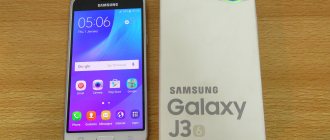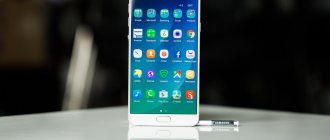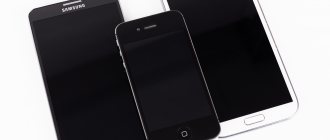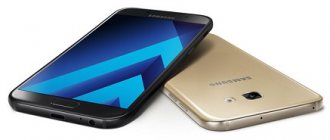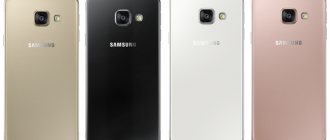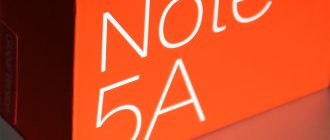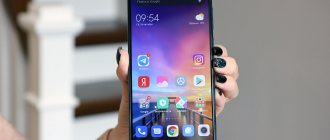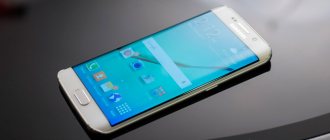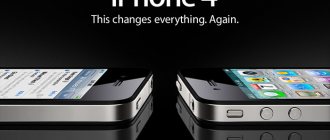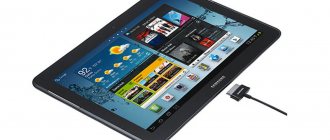Specifications Samsung Galaxy Note 7
| Parameter | Meaning |
| Dimensions | 153.5 x 73.9 x 7.9 mm. |
| Weight | 169 |
| OS | Android 6.0.1 Marshmallow |
| CPU | Exynos 8 Octa 8890/Snapdragon 820 |
| Graphic arts | Mali-T880 M12/Adreno 530. |
| Display | Super AMOLED, 5.7″, 2560 × 1440 pixels, 518 ppi |
| Memory | 64 GB ROM (UFS 2.0) |
| RAM | 4 GB (LPDDR4) |
| Cameras | Main – 12 MP OIS (f/1.7), 4K video recording, front – 5 MP (f/1.7) |
| Interfaces | Wi-Fi 802.11 a/b/g/n/ac (2.4/5GHz), MIMO(2×2) 620 MB/s, Bluetooth 4.2, ANT+, USB Type-C, NFC, microSD (combined), 3.5 mm audio jack. |
| Sensors | Fingerprint and iris scanners, gyroscope, geomagnetic sensor, barometer, heart rate sensor, proximity sensor, light sensor |
| Battery | Li-Pol 3500 mAh. |
Performance and OS
Currently, the device is controlled by Android 6.0.1 Marshmallow OS, but manufacturers promise to update all Note 7 phablets to the seventh version before winter.
The heart of the gadget is the Exynos 8 Octa processor and Snapdragon 820, so high speed is guaranteed. The Mali-T880 M12 and Adreno 530 are responsible for drawing graphics - those who like to play games when free from office routine are not left out.
It is necessary to mention one functional feature - manufacturers have built in a function for monitoring resource consumption. It is enough to get to the corresponding item in the settings, and the smartphone itself will determine which processes are wasting resources.
As for the RAM, there is enough of it to run several “heavy” applications (a special “hello” to the Google Chrome browser) and enjoy the high speed of their operation. Four gigabytes of LPDDR 4 work quickly, are distributed intelligently and correspond to modern realities.
The built-in memory in the Samsung Galaxy Note 7 is as much as 64 gigabytes and, unlike most modern analogues, it can be expanded using an additional memory card, although for most users from the target audience and native space will be enough.
The battery, unfortunately, will last no more than a day during active work. The lithium-polymer battery has a capacity of 3500 mAh, but with reasonable use you can stretch the charge for a couple of days.
Watch right away: Galaxy Note 7 AnTuTu results are impressive
Video review of Samsung Galaxy Note 7
I already said that the Note7 is going to be a big test this year because the difference between the S7 Edge and Note 7 is really small. This is a stylus, USB Type C, +0.2” for the screen, minus 100 mAh for the battery, a new protective glass and an iris scanner. But with the Note 5 there are many more differences. This is new hardware, a slot for a memory card or for a second SIM card, new cameras, curved edges of the display, water resistance, it is 2 mm narrower, and what’s most interesting is that the stylus is no longer inserted with the back side! Plus all the differences from S7. So if you're wondering if last year's Note is worth replacing, yes, I would. But this is my personal opinion; protection from moisture is worth a lot to me.
Design and arrangement of elements
The design is similar to that of other “sevens”: it has a metal frame and glass on the front and back. But unlike the S-series, the glass on both the front and back is equally bent towards the metal frame. Therefore, the smartphone turned out to be symmetrical.
However, I don’t understand where they were aiming and in what symmetry system they inserted the new USB Type-C connector? It is somehow strongly shifted towards the bottom edge.
But the fact itself is very pleasing - for the first time Samsung has a USB Type-C connector. This is just epic cool! I really look forward to the day when there will be only one connector for everything in the world.
In terms of the arrangement of the elements, everything is very similar to what we see in the S7 Edge, except that the S-Pen stylus has been added. However, some elements have changed. For example, I was pleased with the home key; it is now slightly recessed into the frame and practically does not protrude from the body. This means that the scanner will not be scratched as much as before.
The headphone jack is still in place, we exhale, and a new window has appeared above the display. I’ll say a few words about him now.
Housing materials and appearance
New: Samsung Galaxy Note 8 review
Samsung Galaxy Note 7 is made in a metal case, with built-in glass on the front and back. Unlike the other flagship model, the S7 Edge (see review), the glass on the phablet is neatly rounded. This allows you to achieve the maximum level of convenience while using the device.
All the necessary connectors for connecting headphones, charging and a Type C USB port are located at the bottom of the case. The branded stylus is also neatly hidden here. By the way, now, no matter how hard you want, you can’t put the latter in its place with the reverse side.
On the left side there are volume rockers, on the right there is a lock button, and on top there is a universal slot for a memory card and a SIM card.
Separately, we need to mention the USB Type-C connector - this is a new generation of slots into which the cable can be inserted from either side. That is, if the phablet needs to be charged at night, there will be no need for additional lighting to insert the charger correctly.
The home screen return button traditionally contains a fingerprint sensor. The mechanism itself was slightly recessed into the body, so now it does not look like a foreign body, and wear from accidental pressing has become much less.
Iris scanner
In addition to the fingerprint scanner, Note7 adds another level of protection - an eye scanner. You add your eyes once, and then the smartphone unlocks by scanning them. And even in complete darkness. If you look straight, it works very quickly, sometimes you don’t even have time to notice how the scanner turned on. But overall, it’s just a cool feature; it’s unlikely to become a very popular unlocking method, just like face unlock in Android.
TouchWiz interface
The proprietary TouchWiz interface has also undergone dramatic changes. Now all the main settings are placed on a sliding panel. New items and functions have appeared in the configuration menu, such as protected folders for storing content, etc.
Video
Samsung Galaxy Note 7 is primarily aimed at business users. There is also the ability to create quick notes, a high level of security using a fingerprint sensor, a retinal scanner and many other features. But it can be used as a powerful multimedia device for working with media content and playing games. The cameras will definitely appeal to Instagram lovers, and thanks to powerful processors, working with all types of content is quite easy.
The device itself will be supported by the manufacturer for a long time, so it’s definitely worth buying it, if not for work, then as a stylish accessory.
*article will be updated soon
Your rating: ( 5 goals, 4.00 )
Display
On paper, it seems that there are few differences from the SGS7 Edge at all – the screen is simply 0.2″ larger. But in practice, we also have new Gorilla Glass 5, as well as a different shape of curves on the sides. This is the most important difference, making the Note7 much more convenient to use than the S7 Edge. There are a minimum of false clicks on the edge, although they still happen; it is more convenient to hold it in your hand.
The rest of the characteristics are similar: Quad HD resolution, Super AMOLED matrix. The picture remains perfectly readable in the sun, and overall the display leaves the most pleasant impression. Most likely, this is the most advanced screen in mobile devices at the moment.
S Pen
The electronic S-Pen has become a little better in hardware. In particular, the thickness of the rod itself has almost halved - to 0.7 mm, and pressure gradations are now recognized up to 4000. This is twice as much as in the two previous generations, but this is unlikely to help you, it seems to me.
But some software things are more pleasing. What I liked most was the ability to make a GIF from any selected area, be it a menu interface or a video. Here's what happens:
The pen can also serve as a magnifying glass (I can’t imagine any use cases, to be honest), all the previous features remain. I don’t remember if this was possible before, but there is definitely an icon for adding a new item to the stylus drop-down fan. And a whole store for adding items.
Cameras
Neither the main nor the front cameras have changed at all compared to the Galaxy S7/S7 Edge: main – 12 MP, f1.7, pixel size 1.4 microns, optical image stabilization, video recording up to 4k resolution; front – 5 MP, video recording at 1440p.
Therefore, both photos and videos turn out exactly the same, but I still took a few examples of photos for you specifically from the Galaxy Note7.
Sample photos
But the standard camera application has undergone dramatic changes, it has become more similar to that of the Huawei P9. I consider the latter’s standard camera application to be the best among everything on the market, and now the camera in TouchWiz is very convenient. Swiping from left to right brings up the main camera modes, from right to left – filters (it would be better if there were settings, they are still called up by an icon), and swiping from bottom to top or vice versa changes the camera. The change happens very quickly. In general - a test.
⇡#Camera
Samsung Galaxy Note 7, camera module
The camera on the Note 7 moved from the S7 without visible changes - 12 megapixels, physical size - 1/2.5 inches, lens aperture - f / 1.7, optical stabilizer, very fast Dual Pixel phase autofocus with pixel separation. In terms of behavior, the camera also repeats what we saw in the S7 - perhaps with minimal software modifications, but here it is necessary to confront an ordinary flagship with a big one head-on.
The camera application has not changed at all compared to the Galaxy S7: swipe left - you see filters, swipe right - select shooting modes, which, as before, include regular and animated panoramas, hyperlapse (an application for shooting time-lapses), slow motion and special mode for live broadcasting on Youtube.
I didn’t compare the shooting quality of the Note 7 and its competitors now – both because there are practically no differences from the S7, and because in light of the release of the iPhone 7 Plus, the situation in the world of mobile photography is changing. Soon after its appearance in Russia, we will definitely do a large comparative test of the cameras of top smartphones.
I had the Samsung Galaxy Note 7 with me during my trip to IFA. And on the very first day, my camera memory card stopped working. Not knowing for sure whether I had a spare one with me, I wasn’t even worried - the Note 7’s shooting quality allows it to be used as a working tool at exhibitions, especially taking into account the posting of frames on the Internet, where there are no great requirements for detail. Micro sharpness, good ability to shoot in the dark, not the best on the market, but quite functional macro mode, normal white balance. Taking into account the optical stabilizer, which is sorely lacking in the overall remarkable Huawei P9 camera, the S7/Note 7 camera can be considered the most versatile among smartphone modules. Among the shortcomings, we can only note that the focus is not quite reliable in the presence of a clearly defined foreground and that color rendition is not always natural. Software enhancement of contour sharpening may also not be to the taste of some people - images sometimes look “overdone”, excuse the jargon.
Samsung Galaxy Note 7-cameragallery
View all images (28)
As befits a modern smartphone with a powerful processor, the Samsung Galaxy Note 7 can shoot 4K video. An example is above.
The front camera is 5 megapixels, without autofocus. Instead of flash, you can use the screen backlight. Average selfie camera, nothing special. It's a pity that the Koreans didn't use something more interesting in Note 7.
Features and software
In terms of hardware, everything is identical to the S7/S7 Edge: Exynos 8890 with or Snapdragon 820, 4 GB of DDR4 RAM, 64 built-in, expandable with a card up to 2 TB, although these do not exist, battery capacity 3500 mAh. Everything is clear about the performance, it is the same as in the S7, but the autonomy should theoretically be worse, because the display is larger and the battery capacity is smaller. But judging by personal feelings, the difference is not noticeable. The smartphone will definitely be enough for a day of work.
But TouchWiz has been updated again, it is very different even from what is now in the S7/S7 Edge. And this is not bad, updates are, on the contrary, cool. I don’t understand another thing: these updates do not always reach other, still current models. For example, I'm not sure that the new touchwiz will arrive on my S7 Edge. And it’s sad that Samsung uses software updates as a tool to lure away customers; there is always a feeling that you no longer have such a cool smartphone. I hope I was wrong here and the update will arrive soon. And changes can be seen here and there. For example, a safe protected folder has appeared to hide content from prying eyes, an optimization item has appeared in the already changed settings, all items in the curtain now have drop-down functional menus, and so on. Well done, just do the same for other smartphones!
I won’t draw a big conclusion; it’s better to look at my thoughts on whether Note7 will fly. In Ukraine, by the way, the cost at the start of sales will be 25,000 UAH, which is 1,000 dollars. Quite a lot, but buyers will receive an updated Gear VR as a gift. And I recommend immediately getting this flip case, I really liked it. Reliable, beautiful, will not allow your smartphone to break and, what I like most, it easily turns into a stand. For watching YouTube - this is it! All the best.
Please wait…
